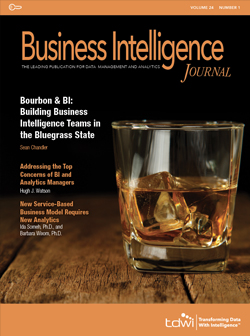
Business Intelligence Journal | Vol 24, No 1
TDWI Member Exclusive
June 12, 2019
Despite enterprises' attempts to adjust to a rapidly changing business landscape, many of yesterday’s problems remain front and center. What worked in the past is often outdated today. In this issue, we focus on modern-day solutions for age-old problems, from staffing and executive support to teamwork and skills development.
Hugh J. Watson tackles several concerns identified at the TDWI Strategy Summit in Las Vegas earlier this year. The goal of the summit is to bring together BI, analytics, and business leaders to discuss “how to best move forward with their firm’s BI and analytics initiatives.” Perhaps not surprisingly, several of the attendees' top concerns were timeless: obtaining and maintaining executive sponsorship; changing the organizational culture for BI and analytics; and investing in BI and analytics staff (that is, improving skills). Watson offers solutions to these and other concerns based on discussions conducted at the summit, the literature, and his own personal experience.
Training is also the focus of Mikael Berndtsson, Christian Lennerholt, Peter Larsson, and Thomas Svahn as they examine the skills and competencies that business users must have for self-service BI. The authors explain strategies for training future users and outline a blueprint for introductory courses on the technology. Four experts also look at the current realities of self-service BI in our BI Experts’ Perspective column. Jim Gallo, Jonathon Geiger, and Brian Valeyko explain where the technology stands and where it’s headed, and discuss what companies and BI professionals should do now to support the technology.
Self-service grew in part from a lack of highly experienced experts. Sean Chandler looks at how your own enterprise can build BI teams where data scientists aren’t readily available to join your group. What is the best source for potential BI staff, where can you recruit talent, and what tips can raise the likelihood of successful BI?
Something else is noticeably changing: the move to a service-based economy. Microsoft’s transformation from selling software products to selling (cloud-based) services has been dramatic. Ida Someh, Ph.D., and Barbara Wixom, Ph.D., explain four key shifts the company had to make and how its BI changed as a result. The authors examine the new service-based business model the company adopted and the new analytics needed to support it. They also offer lessons learned for BI leaders.
In BI StatShots, our survey results look at the rise of cloud computing for analytics workloads.
As always, we look forward to your hearing about your problems and solutions; contact us at [email protected].